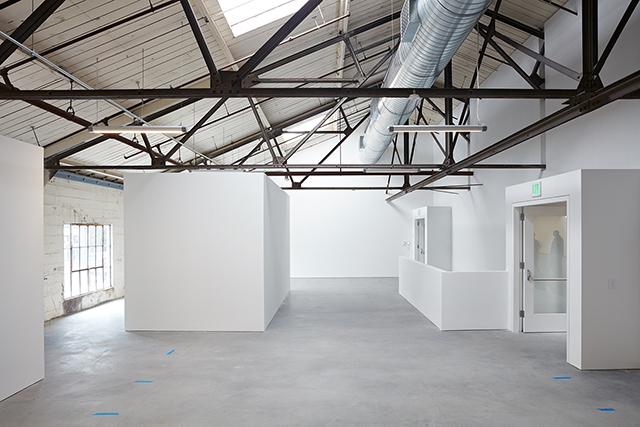New Dogpatch Arts Complex Fuels Hope Amid Evictions and Closures
by Matthew Harrison Tedford
The challenges facing San Francisco’s art community are myriad, and their causes range from the actions of individual landlords to global economic trends. Many individuals and organizations are searching for ways help the arts prosper, from crowdfunding art projects to establishing non-profit asset development trusts.
The Minnesota Street Project (MSP), opening to the public on Friday, March 18, aims to help stem the flow of artists and galleries out of the Bay Area. The three-building arts complex in San Francisco’s Dogpatch neighborhood is the new home for 10 galleries, one arts nonprofit, 35 artist studios, an art storage business, and a restaurant and bar (opening in the fall). The gallery spaces are rented at below market rate, and because of zoning restrictions, artists and galleries do not need to worry about being evicted to make room for offices or condos. The landlords would be unlikely to do that anyway.
Andy Rappaport, a retired venture capitalist and photographer, and Deborah Rappaport, a philanthropist and jewelry designer, undertook this project following a community discussion two years ago about the state of the arts in San Francisco. The Rappaports’ goals for MSP are to provide long-term stability to artists and galleries and to create a hub for contemporary art.
MSP is situated on the eastern edge of the so-called DoReMi (Dogpatch,Potrero, Mission) arts district, home to a number of relocated arts spaces and long-time residents. MSP’s Dogpatch neighbors include Workshop Residence, Romer Young Gallery, the Museum of Craft and Design, the Midway, and the San Francisco Art Institute’s graduate center. Nearby is California College of the Arts, Creativity Explored,fusedspace, San Francisco Center for the Book, Wattis Institute for Contemporary Arts, and several other galleries.
MSP is close to Muni and Interstate 280, yet it can still feel like it’s tucked in a far-flung corner of the city. The 10 resident galleries will host first Saturday openings (the opening month is an exception), a critical mass that might be able to quash the neighborhood’s perceived remoteness. Prior to the neighborhood’s ongoing atrophy, many art enthusiasts dutifully found their way downtown, one Thursday night a month, to the many openings at 49 Geary. MSP possesses the potential to command similar attention with a compelling and diverse calendar of shows. Several MSP galleries are former downtown tenants, including Anglim Gilbert Gallery, Nancy Toomey Fine Art (formerly Toomey Tourell Fine Arts), Rena Bransten Projects, and Themes + Projects(formerly Modernbook).
Joining these established galleries are a number of artist-run and alternative art spaces whose long-term existence could depend on MSP’s alternative business model. In summer 2015, Bass & Reiner Gallery was displaced from their Mission District location. The gallery looked at other potential spaces, but found none with terms as favorable as MSP’s. “Moving into Minnesota Street Project has essentially made it possible for us to continue to exist,” says Emily Reynolds, one of Bass & Reiner’s four co-directors.
For Bass & Reiner, the move isn’t just about survival but the prospect of thriving. “As a stand alone gallery that visitors needed to buzz into and then take an elevator to reach,” Reynolds says of the gallery’s former space within Studio 17 at Mission and 17th Streets, “we could only convince the most adventurous art lovers to come see what we were doing.” At MSP, she’s looking forward to brighter prospects.
“It’s comforting to be in a building where I know I’m protected by landlords that are passionate about the arts,” says Andrew McClintock, director of Ever Gold [Projects] (formerly Ever Gold Gallery), which is moving to MSP from the Tenderloin. But McClintock sees increased opportunity beyond the agreeable rent. He says his new gallery will be bigger and cleaner, and that the Dogpatch in general has more room “to think and breathe” — and to park.
The proximity of established galleries to artist-run spaces is exciting; the potential within these combinations will be on display during the opening night. Anglim Gilbert Gallery shows work by San Francisco-based Enrique Chagoya, an established painter and printmaker whose art is included in major museum collections across the country. A group show at Rena Bransten Projects includes work from prominent visual artists like Doug Hall, Hung Liu, Chip Lord, and John Waters.
Et al. etc. (a second gallery from Chinatown’s Et al.) shows work by Jacqueline Gordon and Margo Wolowiec. Bass & Reiner inaugurates their new space with a site-specific installation by Mie Hørlyck Mogensen and May Wilson. Gordon, Mogensen, Wilson and Wolowiec are all relatively recent art school graduates, a category the 18 California College of the Arts MFA candidates showing in the MSP gallery reserved for outside institutions and curators will soon join.
MSP’s artist studio program also values professional integration. Early-career artists and designers like Beth Abrahamson, Brittany Atkinson, and Henna Vainio will share facilities with an impressive roster of mid-career and established artists, including Lynn Hershman Leeson, Sean McFarland, Mitzi Pederson, and Taraneh Hemami. Various sources have described these studios as renting at or just below market rates, but with terms, facilities, and landlords that would be difficult to find elsewhere.
MSP is not a nonprofit organization, despite its benevolent aims. The Rappaports say that a for-profit structure affords them the flexibility to act quickly. It also allows them to offer services, such as a 100,000-cubic-foot museum-quality art storage facility, that subsidizes the galleries and studios. Cautionary skepticism of this business model is not inappropriate: for-profit business practices regularly push galleries and artists out of the Bay Area, and there will almost always be a venture more profitable than contemporary art. But if the actions of landlords speak to their values, optimism like Reynolds’ and McClintock’s may be warranted.
See you at the opening.
